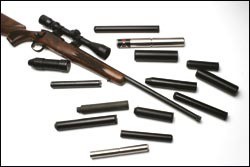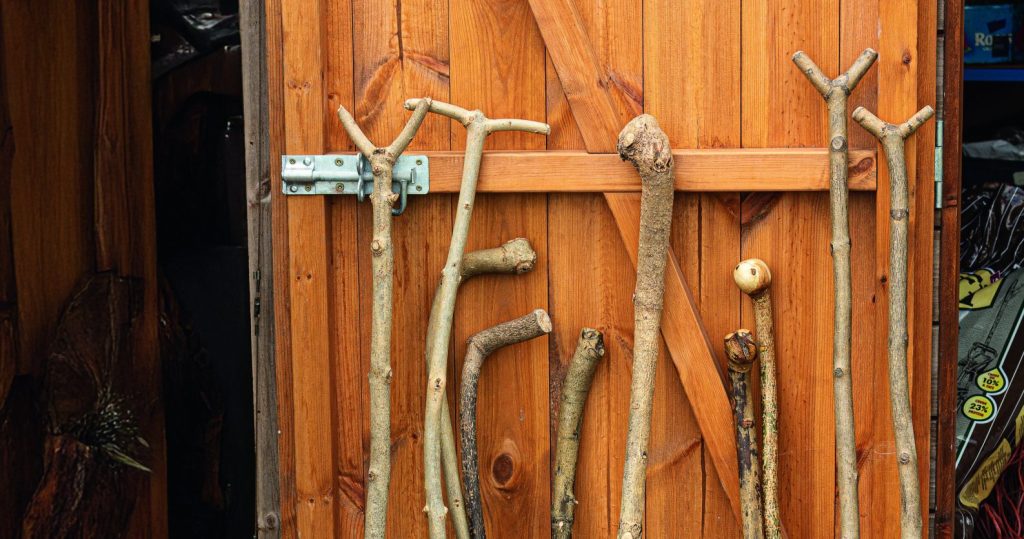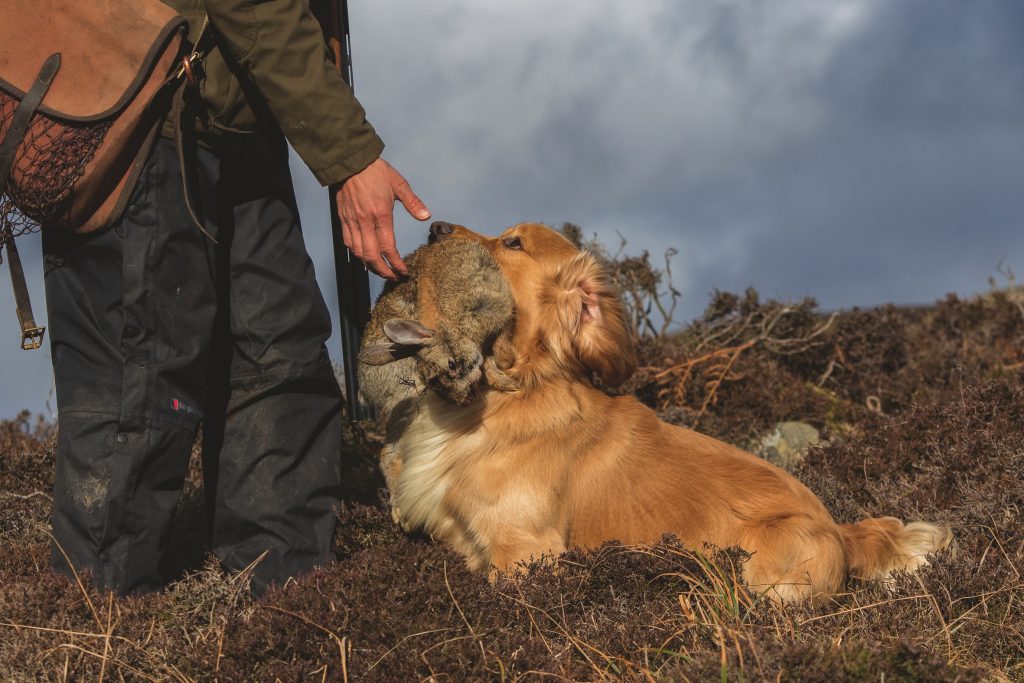Win CENS ProFlex DX5 earplugs worth £1,149 – enter here
Sound moderators for .22 rimfires
Here Shooting Times offers you a best-buy guide to sound moderators for .22 rimfires.

The humble .22 rimfire is undoubtedly one of the gun world’s success stories.
Most Rifles cut their shooting teeth on one, and as a vermin tool it is unparalleled. The sound moderator should certainly form part of the rimfire purchase, especially if it is for culling rabbits and subsonic ammunition is used.
As with the rifle itself, prospective buyers have a vast choice of moderators to choose from, so how does one decide which is the best to buy?
Finding a benchmark
There are myriad sound moderators to choose from ? this includes differences in style, length, weight, material of manufacture as well as muzzle-mounted or over-barrel designs. There is also a big difference in prices. To keep things simple, I elected to rate each moderator on a scale from one to five, with one being excellent and five being adequate. As a benchmark, I chose the venerable Parker Hale ? probably everyone’s first moderator ? which I rated at a good, solid three. I judged all the other moderators against it. I only used subsonic ammunition from Remington and Eley for testing. This would achieve the best possible noise reduction from each moderator. A Browning T-Bolt and Remington 504 rifle were used.
Each moderator was tested from a bench, shooting across a field with an unrestricted field of view for 300 yards, so there were no problems with unwanted reflected noise. Only the effectiveness of the noise suppression was recorded. To test the moderators in a more realistic environment, I also shot from a wood into an open gulley of 250 yards, where there would be reflective noise. I did not use a sound meter to record results. Though I own one, to get a true reading of decibels you need a £5,000 meter. For these tests, I felt a comparison between each moderator ascertained by three independent witnesses would suffice to obtain an unbiased result.
A baffling choice
What was immediately obvious was how good the pressed steel baffles and slim design of the Parker Hale were. To improve on it a moderator would not only have to prove noise reduction, but also longevity, be light of weight and easy to assemble. Rimfires are notoriously dirty cartridges, leaving lubricating wax and burned and unburned powder in the moderator, so the ability to strip for cleaning can be just as important as noise reduction. Many of the moderators tested use variations on the simple stack of identical individual baffles. These decrease the forward flow of gas while retarding and cooling it, thus reducing the noise level as the gas leaves the moderator. Some use synthetic materials to save weight and some use stainless steel for longevity, though this does add weight.
To simplify the internal design, some manufacturers use a single machined baffle stack that can be removed in one piece, while others use a sealed unit with minimal internal surface area. Most are muzzle-mounted cans with all of the moderator extending forward of the rifle. There are a few over-barrel designs, which reduce the forward length considerably. Most of the moderators tested performed well and rated above the three rating, but there is an enormous difference in price and sometimes extra money does not buy better decibel reduction.
Phut, thut or thong
A .22 rimfire burns only a small amount of powder, so you do not need an enormous volume of moderator to suppress it effectively. In fact some of the larger cans proved to be noisier, as the muzzle blast burned more oxygen within the moderator and acted as an echo chamber. There was also an interesting scale of muzzle reports. These can be, crudely speaking, divided into three categories: soft phut, thut and hollow thong noise. This may sound a bit strange but it’s the best way to describe each moderator’s sound.
The best moderators on test
There were two clear winners, each with a very different design. John Bowkett is famous as a bespoke airgun designer, so the quality of his rimfire moderator came as no surprise. It is a sealed unit made from flawlessly blued steel that only has three baffles within the moderator. However, the internal area and arrangement of the baffles and their shape reduces the report of a subsonic rimfire to that of a very soft phut very effectively. There is an interesting ring as the bullet exits but there is no other noise. It is a simple, compact and lightweight moderator.
Just as good was the long 9.5in Vaimeco moderator. It has an aluminium casing, with a one-piece synthetic baffle stack. This moderator stifles the muzzle blast with its length to an end report of a soft phut. The Vaimeco is light, but it is very long. It is also becoming harder to find in shops as it is being discontinued ? but it is a moderator worth hunting for.Next there were a few moderators that were nearly as good as the Bowkett and Vaimeco, but these had a different muzzle report noise. Four moderators fell into this category: the AU rimfire, the PES 32mm can, the Logun and the A-Tec rimfire. Each had differing designs but produced the same thut noise.
The AU rimfire and the A-Tec used a multiple baffle stack of individual baffles, the AU rimfire has an additional hollow outer core, thus offering a twin-layered skin. The A-Tec offers the same noise reduction, but has 14 baffles in a series to reduce the report. The PES 32mm muzzle can is made from stainless steel and is sealed, but it has a large hollow initial expansion chamber followed by a baffle stack, while the Logun is strippable and has a vented core and spring arrangement with a noise-reducing flame-retardant fabric to reduce internal vibration noise.
The Sako aluminium and synthetic one-piece baffle-stack muzzle can came out as a two to three rating purely because it had a slightly louder initial start to the thut noise. However, this is still a light, well-priced moderator. The PES 32mm was similarly rated, but it had a sealed stainless steel construction with additional weight and higher price.
The next three ratings were the PES P/H strippable, the A7, the Wildcat Cub, the Parker Hale, the Sirocco and the JLS Stalker. The PES is similar to the Parker Hale in its design, but it is made of stainless steel. Both have removable stacks of individual baffles and both reduced the noise of a subsonic bullet perfectly well and are all you really need. The Sirocco has a coned baffle column and the JLS Stalker use springs and washers to achieve the same goal. The Wildcat Cub is different in that it is very small, light and made of Delrin (polymer), and the baffle stack is one piece and comes out as part of the end cap. The oddity was the new A7.
This is a large moderator and one of the over-barrel designs which, because of its large internal volume, was too much on a .22 rimfire. In my view it would be better suited to a .17HMR, and it was expensive, too, at £160. Falling short of the average mark, but still offering a good level of noise reduction was the Sound Biter, which we rated at three to four. It was very short and, at an extremely reasonable £19.95, offered good value, being an effective sound reducer, too. The SAK came in at the same rating. This has a plump, short stature consisting of only an outer case and a one-piece baffle stack. It offers good noise reduction, a reasonable price and easy cleaning.
The Wildcat Growler and Mighty Mouse scored a four, the former being an over-barrel design, which adds only 4in to the overall length of the rifle. The Wildcat Growler is constructed of aluminium and so is very light, but it is relatively expensive and had a hollow thong ring to it. The Mighty Mouse is a shorter Parker Hale-type design. It was not as good as some of the longer moderators tested, but it was very light and well made. Last to be tested was the Husher One moderator which scored a four to five. Though it is strippable, with no internal parts to clean, it produced a louder thwack report that definitely reverberated off the trees.
The market for moderators
The little T-Bolt rifle consumed more than 1,000 rounds of subsonic ammunition in the tests so as to be able to pinpoint the subtle differences between each moderator. When choosing a .22 rimfire moderator there are a few things to bear in mind. Are you happy with the excellent noise reduction offered by the old Parker Hale? Or do you wish to spend more and have peak performances? Perhaps you are after the lightest moderator or perhaps the easiest to clean?
If overall length is an issue then an over-barrel design may be preferable, but that may affect the noise reduction. Or perhaps you simply want the biggest moderator on offer? I hope the results (see the table below) will give you an informed choice of the current moderators on the market. Remember that the best kit does not mean you have to work any less hard on your marksmanship and fieldcraft. Ultimately those are the things that truly make a difference.
Read more gun reviews!
Related Articles
Get the latest news delivered direct to your door
Subscribe to Shooting Times & Country
Discover the ultimate companion for field sports enthusiasts with Shooting Times & Country Magazine, the UK’s leading weekly publication that has been at the forefront of shooting culture since 1882. Subscribers gain access to expert tips, comprehensive gear reviews, seasonal advice and a vibrant community of like-minded shooters.
Save on shop price when you subscribe with weekly issues featuring in-depth articles on gundog training, exclusive member offers and access to the digital back issue library. A Shooting Times & Country subscription is more than a magazine, don’t just read about the countryside; immerse yourself in its most authoritative and engaging publication.







